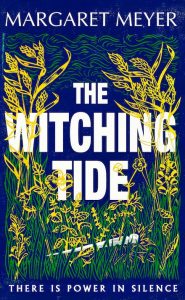Author: Margaret Meyer
Title: The Witching Tide
Publisher: Moa Press/Hachette, 2023; RRP: $32.99
Margaret Meyer has a wealth of experience, having been born in Canada, grown up in New Zealand where she began her working life, and subsequently working and studying in the UK. She was a journalist and fiction editor in New Zealand, and, in the UK, publishing director for the Museum of London before being appointed Director of Literature with the British Council. She then trained as a mental health therapist and worked in a variety of settings including schools, prisons and addiction recovery centres, as well as her own private practice. She completed an MA in Creative Writing at the University of East Anglia before writing The Witching Tide, and now lives in Norwich.
Her location provides the inspiration for this novel. During the middle years of the 17th century, a witch hunt took place in East Anglia in which at least 100 innocent women were executed. In Britain few witch trials took place in the Middle Ages, however, the majority occurred in the 1600s, reaching a peak during the 1640s of the English Civil War and the Puritan era of the 1650s. Records indicate that about 500 people, more than 90 per cent of them women, were condemned to hang as witches or were burned at the stake (if convicted of another crime at the same time) during this period. One hundred people from one small area constitutes a significant proportion of the population at the time. The women who were targeted were often old, with a bad reputation amongst their neighbours, or who had particular skills with herbs and other healing techniques.
Martha Hallybread, the protagonist of this story, is neither particularly old, being in her 40s, nor with a poor reputation; she is the ex-nurse of her master, Kit Crozier, and now works as a sort of housekeeper for Kit and his wife, Agnes, who is pregnant with the couple’s second child – the first had died at birth. Martha is also the local midwife and is known for the healing qualities of her ‘physick garden’. She has always been mute, communicating by a system of hand signals and gestures, well known to those around her but more difficult for strangers to interpret. Kit is a merchant, and a kind man who treats his servants as family, especially Martha, as it was she who essentially raised him.
@ the Spinoff
The book opens with one of the young servants, Prissy, being taken by a gang of men working for the witch hunters. This begins a time of great upheaval in both the household and the town of Cleftwater. People turn on one another, interpreting illnesses and hardships as evidence of witchcraft amongst some of the local women. At Kit’s bidding, Martha becomes one of the assistants to the witch hunters, seeking marks of the devil on her fellow villagers in order to try to save Prissy.
And Martha has a secret – a collection of items left to her by her mother, amongst them a wax doll, called a poppet. When Martha realises the danger that is looming, she retrieves this poppet from the box of her mother’s items and ponders over whether she should use it, and if so, how. Ancient beliefs, predating the Christianity of the time, seem to inform Martha’s understanding of the power of the items bequeathed by her mother.
Margaret Meyer talks about witch trials and the lessons perhaps not learnt
@ saturday morning on rNZ
Over the course of about two weeks, we see the whole town become consumed with the witch hunt and how this has an impact on everyone from the priest and the judge, to the poorest of the townsfolk, and especially on the Crozier household and their friends. The weather becomes an additional character when persistent rain causes flooding, adding to the misery of the accused women.
There are gritty and disturbing descriptions of the place the women are imprisoned, as well as the other torments they are subjected to in the effort to determine whether or not they are witches. As was the situation at the time, even the most benign events are twisted to provide ‘proof’ of cavorting with the devil or his imps, or of intent to harm neighbours. Martha’s inability to utter spoken words also works against her, allowing inaccurate interpretations of her signing and gestures.
Martha, unlike some of the other characters, ultimately survives the ordeals enacted by the witch hunters, but it is not clear exactly how this happens. It is also difficult to determine how much Martha believes in the power of the poppet and whether she is really at ease with its use. This could just reflect the confusion of the time and be a deliberate device used by the author. However, it means that the Martha character remains enigmatic in relation to her inner thoughts and reasoning. What is not enigmatic, however, is the horror of the events and the unjust ways in which women were treated during that disturbing time.
Reviewed by: Elisabeth Bridson
Ballarat Writers Inc. Review Group
Review copy provided by publisher

Leave a Reply